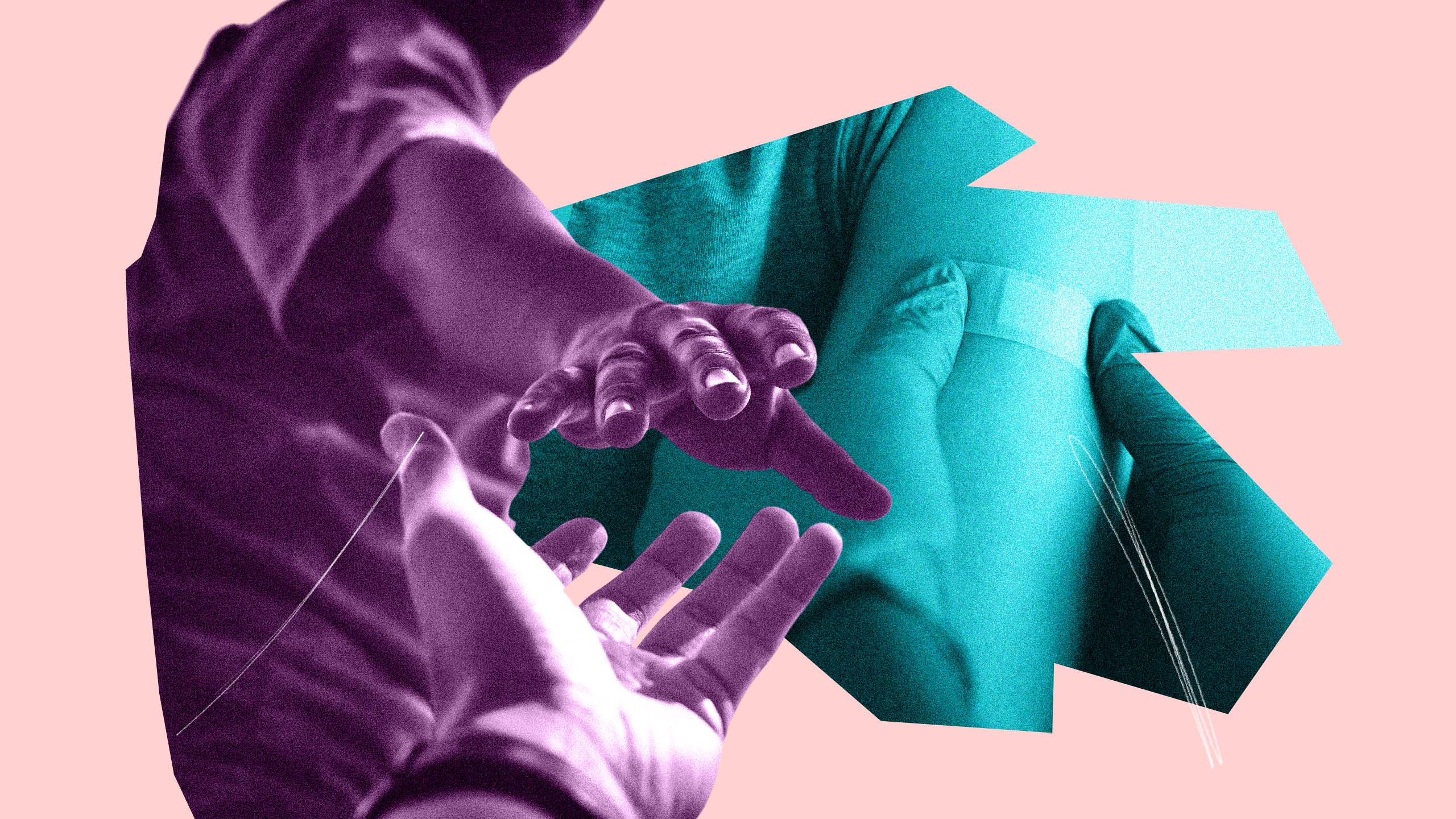Mpox was the spectre that hung over summer 2022—especially this year’s Pride celebrations. It was—pardon the pun—a blister on an otherwise restrictionless few months of gatherings and reunions.
At the time, the virus was a legitimate cause for concern. In May, mpox (pronounced “em-pox,” a newly coined term for the virus that aims to sidestep confusion about transmission, as well as racist or homophobic stereotypes) spread quickly beyond the few African regions it was typically isolated to.
Throughout June, July and August, hundreds of Americans and dozens of Canadians were testing positive for mpox every day, struck with painful sores and flu-like symptoms. These diagnoses were near universally among queer men. In July, the World Health Organization (WHO) declared mpox a public health emergency and accelerated approval was given to a vaccine (branded as Imvamune in Canada, JYNNEOSs in the U.S. and Imvanex in Europe). People lined up, sometimes for hours, to receive their first of two shots.
Yet fast forward to today and mpox seems to have largely dissipated in many non-endemic countries. Throughout October, only between one and three Canadians were testing positive for mpox every day. Several days passed with no new cases. By mid-October, Ontario’s chief medical officer considered declaring the outbreak over.
In the United States—the country with the greatest number of cases this year, with more than 29,200 total—only 14 people across the whole country were testing positive on November 16. Two weeks ago, WHO reported that the number of weekly new mpox cases declined 80 percent from the peak in August. Across 11 European countries, fewer than 50 people tested positive over a two-week period in October and November.
Make no mistake: the virus isn’t gone. In fact, right now WHO is asking its global members for more than USD $33 million to target mpox responses for regions that haven’t seen as sharp of a decline in cases—such as Africa and Southeast Asia. But what can be said about the substantial downward trend elsewhere?
To start, we’ve learned that the virus is harder to spread than initially feared. Early public health guidance warned of potential transmission through saliva particles, like how COVID-19 is spread. But more recent studies found that there isn’t much of the virus in the upper respiratory tract. Rather, swabs from lesions on the skin contained 17 times the infectious virus particles than swabs from the throat. Likewise, samples from the anus and semen contained more virus than those from blood or urine—helping to explain why the virus was exploding among queer men, but few other demographics. Yet even if mpox was never going to break out of queer circles, it could have raged for months longer within these groups. Instead, the opposite happened.
“Every pathogen is different, and to try to characterize how usual or unusual it is for mpox to drop this fast—I don’t know if we can answer that with complete certainty,” says Dr. Troy Grennan, an infectious diseases physician and HIV/STI lead at the BC Centre for Disease Control. “But we can really credit community action for the success we’ve seen, be it with vaccine uptake or the messaging and education around mpox symptoms and self-care.”
It’s true that there was little hesitancy with vaccine uptake in the queer community. Because of the demand for vaccines, by August both U.S. and Canadian regulatory bodies allowed the use of intradermal injection for mpox, a method that injects the vaccine just underneath the skin’s surface instead of into the underlying fat. This approach gets the same vaccination results with one-fifth of the dosage, stretching quantities further—the primary drawbacks are more redness, itchiness and swelling at the injection site.
“Montreal, a city once considered the epicentre of Canadian mpox transmission, has seen almost no new cases this past month.”
Despite the pressure on supply, by the start of November, more than a million doses of the vaccine had been administered in the States and more than 100,000 doses in Canada, with about a third of those doses given to people in Quebec. This is a consequential figure considering Montreal, a city once considered the epicentre of Canadian mpox transmission, has seen almost no new cases this past month—a milestone the queer community worked hard to reach.
Alexandre Dumont Blais, the executive director of RÉZO, a Montreal-based group for gay, trans and bisexual men, says his team and other local supports were quick to mobilize as soon as the first reports of North American mpox cases were reported. “I was in meetings with public health authorities from day one.”
From there, it was easier to roll out a comprehensive campaign promoting vaccines and symptoms in partnership with officials. “We already have contacts with different community leaders, bars, clubs, with Pride—places our communities go,” he says, citing mpox social media videos RÉZO made with contestants from Drag Race promoting vaccination as a rapid and effective outreach response. “When we need to reach out urgently, it’s really easy for us. We know what to say and how to talk to people because we are part of the community.”
But to say vaccination outreach was a success everywhere would be an oversimplification. To start, LGBTQ2S+ groups had to push for more information about and access to vaccines during those crucial June weeks before major Pride celebrations began in cities like Toronto and New York.
As well, questions remain about who got those vaccines and when. In the U.S., for instance, queer men make up the bulk of mpox diagnoses, but in the early weeks, the racial breakdown within this group initially mirrored the country as a whole. People getting mpox around May and June were mostly white, followed by Latino and a smaller percentage Asian or Black.
But as the summer went on—and as the mpox vaccine began to be doled out—the number of Black Americans testing positive began to dwarf any other racial group, representing more than a third of new cases despite making up just over 12 percent of the population.
This jarring flip could be for a number of reasons, says Victoria Kirby York, deputy executive director of America’s National Black Justice Coalition. “The places that had testing earliest were California, New York, D.C.—places where Black LGBTQ2S+ people live for sure, but how much testing was going on in Mississippi? In Georgia? In Louisiana?”
Similarly, if you look at some of the manifestations of mpox says Kirby York, Black people are disproportionately impacted by certain autoimmune disorders, like sclerosis and lupus, that exhibit on the skin, so queer Black people may not have recognized or differentiated mpox symptoms early enough.
This tracks on the vaccination side as well, with only 11 percent of America’s nearly 700,000 first doses going to Black Americans even as the rate of transmission within this group jumped above all others. Here, too, Kirby York illustrates how challenging it can be to live in the intersections of two marginalized groups. Health agencies would direct effort and funding to mpox campaigns and clinics in queer venues that aren’t necessarily welcome to all queer people.
“We don’t live in ‘gaybourhoods’ because of the racism we often endure in those spaces,” Kirby York says. “You got the LGBTQ2s+ portion right, but we don’t live over there, we don’t work over there.”
Vaccines, however, can’t account for all of mpox’s dramatic decline. Changed behaviour is another indicator for transmission and here the story is also less rosy.
There was, for example, early friction between government agencies and queer communities around prevention approaches. While vaccines remained limited, public health officials asked people at risk of mpox—again, almost exclusively queer men—to be cautious of being physically intimate with each other and for those who did test positive to isolate for at least 21 days. At the time, there was no financial aid for people who were isolating, which many queer advocates felt paralleled the HIV epidemic, where many queer men were left to suffer alone and without support.
Still, queer men did get their guards up. Evidence suggests a large portion did, in fact, change their sexual habits to prevent getting mpox, and there was almost universal awareness of the virus and its symptoms among queer men. Unlike the COVID-19 pandemic, mired in disinformation and resistance to restrictions, the queer community’s response to mpoxwas primarily one of information-sharing, organizing and conscious behaviour change. And despite the limitations on when and with whom mpox information was shared by public health authorities, there’s broad consensus that these past several months have been ones of partnership.
“As healthcare providers, researchers, policy makers, stakeholders, we finally listened to what the community—and particularly the queer community, which has been so active in health advocacy for decades—has been saying from the very beginning,” says Grennan.
“This is the first time I’ve seen such an early and meaningful involvement of the community.”


 Why you can trust Xtra
Why you can trust Xtra


